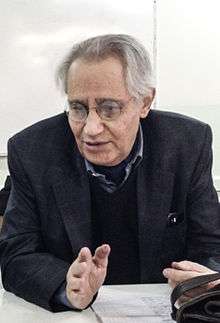Ali Akbar Saremi
Ali Akbar Saremi (1943 – 2017) was an architect from Iran. Saremi earned a Masters in Architecture from the Faculty of Fine Arts, University of Tehran, in 1968. He got his doctorate in architecture under the supervision of Louis Kahn from the University of Pennsylvania, in 1976.
Ali Akbar Saremi | |
|---|---|
 Saremi in 2013 | |
| Born | 28 October 1943 Zanjan, Iran |
| Died | 21 January 2017 (aged 73)[1] |
| Nationality | Iranian |
| Education | Tehran University (M.A.), University of Pennsylvania (PhD) |
| Occupation | Tajir Consulting Engineers |
| Years active | 1974–2017 |
Philosophy
Saremi is a well-known figure in contemporary architecture, for construction projects involving limited urban spaces. In an interview with Taghi Radmard (Bahram Hooshyar Yousefi) he stated: "We designed the building in this way that solve the issue of neighborhood (in case of a school for girls). Moreover, school became a happy space and a happy space needs happy and bright materials. Some colors, trees, light shadows have to hide, space for children to hide... Spaces do not have to be defined, only." He also spoke about Persian architecture.[2][3][4]
Career
Saremi was Chairman of Tajeer Consulting Engineers beginning in 1968. He was a lecturer at Farabi University (now known as the Isfahan University of Art) from 1976 to 1980. He was a lecturer at Islamic Azad University from 1994 to 1997.
Projects
Saremi's major projects include the Pasteur Institute Amphitheater in 1988, the Iranian Embassy in Albania in 2000, commercial buildings and offices of crystal towers of Tabriz in 2001, the commercial and cultural city of Mashhad in 2004 and the exhibition and office complex of Kish in 2005.
References
- "علی اکبر صارمی درگذشت". Mehr News Agency (in Persian). 2017-01-21. Retrieved 2017-11-06.
- "زندگینامه: علیاکبر صارمی (1322-)". Archived from the original on 2011-12-02. Retrieved 2012-01-08.
- "Ali-Akbar Saremi in Conversation with Faryar Javaheriyan Mehrjui". Archived from the original on 2012-07-08. Retrieved 2012-01-09.
- A R U N A :: Features